
Seabirds have highly sensitive beaks to locate food
Seabirds such as penguins and albatrosses have highly sensitive regions in their beaks that could help them locate food, according to a new study from the University of Cambridge.
“Birds’ bills are their main tactile interface with the outside world. Tactile bill-tip organs associated with specialized foraging techniques are present in several bird groups, yet remain understudied in most clades,” noted the study authors.
Nerves and receptors in seabird beaks
By studying over 350 species of birds, the experts found that seabirds have a high concentration of sensory receptors and nerves at the tips of their beaks. This trait has previously been observed in tactile foragers like ducks.
According to the scientists, this touch-sensitive area may have originated from a common ancestor. However, further research is needed to determine whether this trait serves a specific function in today’s birds.
Sensitive beak-tips to assist in foraging
Birds use their beaks similarly to how humans and other primates use their hands, interacting with the world around them. Some birds have touch-sensitive beak tips to assist in foraging, but the extent and evolution of this ability have not been well studied.
“Many scientists had assumed most birds had touch-sensitive beaks, but we hadn’t investigated it enough to know whether it’s a common ability, or whether it’s limited to particular families of birds,” said lead author Carla du Toit from Cambridge’s Department of Earth Sciences.
Endangered group of seabirds
The large group of seabirds known as Austrodyptornithes – which includes albatrosses, petrels, and penguins – has not been well-studied in this context.
Since many species within this group are critically endangered, understanding how they use their beaks to find food could aid in their conservation.
Du Toit and her colleagues from the UK and South Africa conducted a study of 361 modern bird species, examining fossil and skeletal records as well as birds that had been accidentally killed by fishing gear. They focused on the structure of the beaks and how they are connected to nerves and blood vessels.
Organs in the beaks of seabirds
The researchers discovered that albatrosses and penguins possess organs in their beaks containing dense clusters of sensory receptors and nerves. This feature is commonly found in tactile foragers like ducks, but this is the first time it has been observed in seabirds.
“Seabirds aren’t known to be tactile foragers, so it’s surprising to find that they have this organ,” said du Toit. “It’s really exciting when you get to be the first to see something.”
Detecting tiny vibrations from prey
These touch-sensitive beaks might enable seabirds to detect tiny vibrations from potential prey, especially when foraging underwater or at night. Birds with similar abilities are known to use their beaks to detect subtle movements from prey like worms underground.
However, it is also possible that these sensitive regions are a remnant from a common ancestor and may not serve a specific purpose in modern birds, much like certain features found in ostriches and emus.
Further research on live birds will be required to determine the precise function of these touch-sensitive areas, which could also shed light on their evolutionary history.
Remarkable discovery in seabird beaks
“In humans and other primates, our sensitive hands and fingers allowed us to master a huge range of environments,” said du Toit.
“Beaks are analogous to hands in a way, but this is the first time we’ve seen touch-sensitive beaks in seabirds. It’s remarkable that no one has ever really studied this in detail, considering that we all learn about evolution from the beaks of Darwin’s finches in school.”
The researchers noted that the bill-tip organ in Austrodyptornithes may be functionally related to nocturnal foraging and prey detection under water, or courtship displays involving tactile stimulation of the bill.
“Ancestral state reconstructions fail to reject the hypothesis that the last common ancestor of Austrodyptornithes had a bill-tip organ; thus, tactile foraging may be ancestral for this major extant clade, perhaps retained from a deeper point in crown bird evolutionary history.”
Broader implications of the study
The researchers believe that their findings could contribute to the conservation of seabirds. Of the 22 known species of albatross, 15 are at risk of extinction, and two are listed as critically endangered.
One significant threat to albatrosses is commercial longline fishing, which causes about 100,000 bird deaths per year when they get caught in fishing lines and drown.
If scientists can better understand how these birds find their food, it might lead to methods for protecting them.
According to du Toit, if albatrosses and other seabirds are able to detect vibrations from potential prey via their beaks, it could be possible to attach some sort of device to longlines that could repel them, so they are less likely to get caught.
“Of course, the bigger threats to birds like albatrosses are climate change, rising ocean temperatures, plastic pollution and falling fish stocks, but if there’s a way to reduce the risks to seabirds in even a small way, then that’s incredibly valuable,” du Toit concluded.
The study is published in the journal Biology Letters.
—–
Like what you read? Subscribe to our newsletter for engaging articles, exclusive content, and the latest updates.
Check us out on EarthSnap, a free app brought to you by Eric Ralls and Earth.com.
—–













